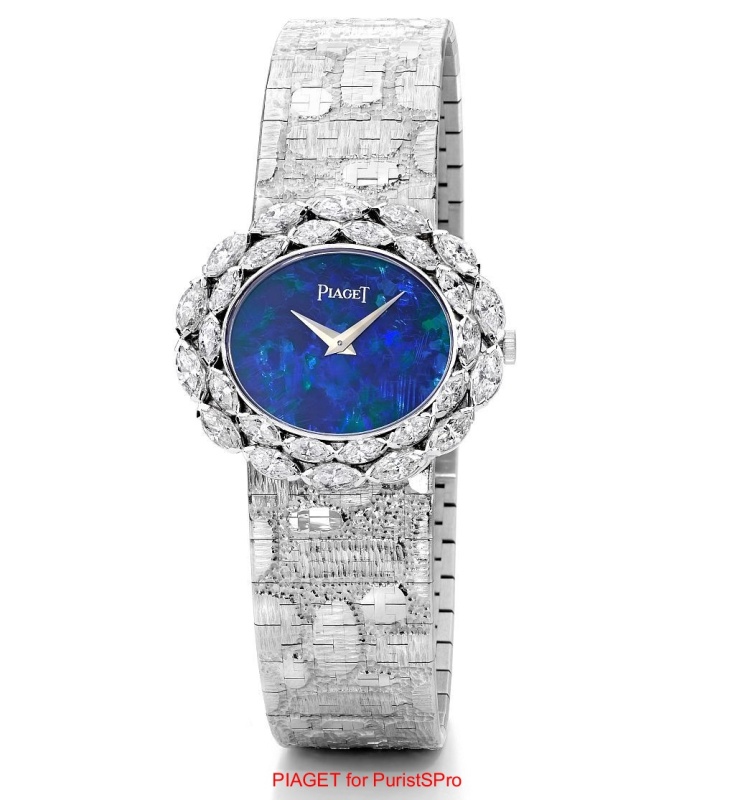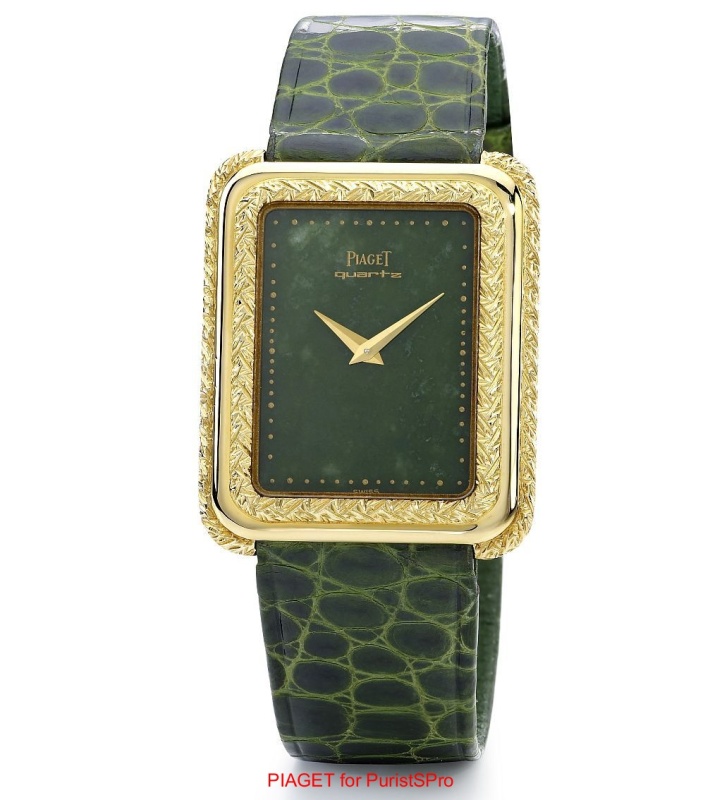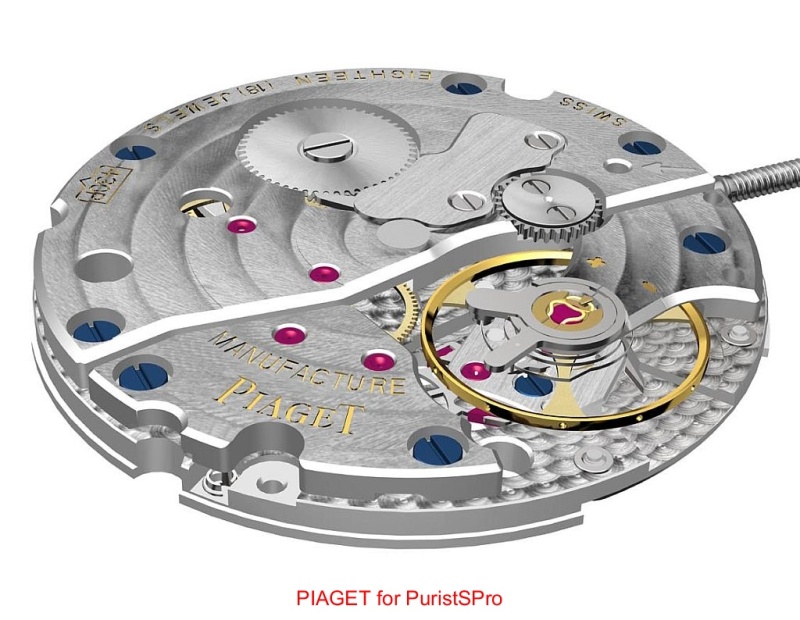
MTF
[PuristS]
13383

Piaget Technique & Aesthetic Part 5: Hard Stone Dials
Piaget Technique & Aesthetic: part 5 – Hard Stone Dials
Once upon a time there was Piaget….
Piaget is a story of time, but also of what the Francophiles call "audacity" and inspiration. "Audacity" means something completely different to English speakers so it was a while before I realised that my friends at Piaget were on to a good thing and not being presumptuous!

Proudly merging time-honed expertise and innovation since 1874, the Maison from La Côte-aux-Fées creates watches and jewellery that are renowned far beyond the confines of their home patch of Neuchâtel Jura mountains. Run as a family firm for generations and still with the homely feel today despite the juggernaut that is Richemont Group, Piaget is still able to inspire new trends, and to find their way unscathed through the decades.

Ultra-thin horology
Loyal to its pioneering spirit, Piaget began designing and producing ultra-thin movements right from the start. The famous ultra-thin mechanical hand-wound 9P calibre, presented in 1957 and measuring a mere 2 mm thick, was to leave an indelible and historical imprint on the watch industry. Three years later, Piaget launched Calibre 12P, the world’s thinnest automatic movement at just 2.3 mm thick, and described by the influential Journal de Genève as a “milestone event in watchmaking history”.
Thanks to their slenderness and their compact nature, these two mechanical calibres and their successors were to open up whole new vistas for Piaget designers, paving the way for all manner of bold creative moves including cuff-watches, coin-watches, shaped cases and hard stone dials.

Back in the 1960s, Piaget used stone as structural components and not just decoration. After making their first appearance on Piaget dials, jade, lapis lazuli and opal were then used on watch bracelets from the 1970s onwards.




This represented a revolution combining the nobility of hard stones with a broad range of colours and was perfectly in tune with the fashions of the time. Pure creative genius..... from "Groovy, Baby!" of the Stoned Sixties to "May the Force be with you" of the Funkadelic 70s .

Now in 2013, Piaget returns to their stone dials that started the Swinging Sixties and Psychedelic Seventies. Let's see where the technique and aesthetic of Hard Stone Dials come together at Piaget.
LAPIDARY
A lapidarist is an artisan who works stone, mineral, and gemstones into decorative items, including cameos, or cabochons, and faceted designs. The specific techniques are tumbling, cabochon cutting, and faceting.


Another technique used is pietra dura or pietre dure ("hard stone" in Italian). It is also named 'parchin kari' in India. This inlay technique of using cut and fitted, highly-polished coloured stones to create images.
The stonework is glued stone-by-stone to a supporting material after having previously been "sliced and cut in different shape pieces. The pieces are assembled together so precisely that the contact between each section was practically invisible. Stability is ensured by making grooves on the undersides of the stones so that they interlocked, like a jigsaw puzzle, with everything held tautly in place by an encircling 'frame'. In Europe, the technique first appeared in Rome in the 16th century, to reach full glory in Florence. Many different colored stones, particularly marbles, were used, along with semiprecious or precious stones.

These stones are extremely fragile and hard to cut, which means that working with them requires a combination of controlled gestures and considerable dexterity. The extreme finesse of the cut-out shapes represents a major technical feat and calls for highly experienced artisans. Each stone reacts differently to the cutting operations and will look different according to its thickness.
Although the tools used to cut stone are now more advanced, the techniques of lapidary have not changed since primitive man created stone tools. Although the market for ornamental stone has grown substantially over the past few years, the population of skilled lapidarists continues to shrink making lapidary a highly sought skill.
Transforming rocks into ornamental stones is not easy. Lapidary is a physically challenging artform. Apart from the physical danger of flying debris and sharp instruments, exponents are at risk of chronic lung disease from dust or fungal spore inhalation. A Master lapidarist must be proficient in practical material science and geology. Mineral composition and the texture of rocks differ according to variation in geological history thus, physical properties are not standardized, not even amongst samples of the same species.
Such physical characteristics (elasticity, compressive strength, modulus of rupture, friability) are negligible when small sculptures are produced but they become important considerations when thin discs for dials are required. Unfortunately some beautiful stones cannot withstand the internal stresses and strains that occur; for larger watch dials, delicate stones like Opal cannot be used.

One of the most important properties of lapidary material is the colour. The color of a stone is a result of light rays that are absorbed or reflected in the material. Perception of colour is also influenced by the stone texture, lustre, transparency or opacity, size, inclusion patterns, and the source or type of light. The real skill of lapidary is optimizing these optical properties.
The lapidary techniques required to manufacture a stone dial are sawing, grinding, sanding, lapping, polishing, and finally drilling.
The first step is sawing through the rough rock sample. Ideally rough material should have good colour/pattern, uniform texture, freedom from large fractures, stains or unwanted inclusions.

Some stones are extremely rare and seldom come to market in sufficient quality and quantity. Pietersite (variation of tigereye) for example, is extremely rare because it has been "all mined out", according to South African authorities.
When sawing, lapidarists use a thin circular blade with its outer edge impregnated with diamond grit to cut through a rough stone sample. A liquid such as oil or water is used as a lubricant and coolant to prevent thermal damage to both the equipment and stone.

This initial step really determines the final appearance of the finished stone dial. Cuts along different orientations or axes on the same stone may produce different color hues and patterns. An expert cut will not only enhance the natural color of the stone but by capitalising on the natural cleavage planes, the durability of the final dial can be increased. By the end of this step, a large percentage of the original rough stone is wasted while yielding only enough material for a few stone dials.

After cutting into thin sections, outlines of shape and diameter of the dials are made. By grinding and sanding using finer abrasives each time, precise control over the shaping of the stone disks transform them into perfect circular dials
Lapping is the next technique. Lapping removes material like sanding or grinding, except that sanding and grinding use abrasives that are fixed (bonded abrasives) whereas lapping abrasives are suspended in a liquid carrier, and are free to move about. Performed on one side of a vibrating flat disk, lapping is used to create flat surfaces on a stone.

The stone dial is sandwiched between the vibrating disk of the lapping machine and a weighted metal cylinder placed eccentrically to smooth out a specific portion of the dial. The brown liquid is the abrasive while the number on top of the cylinder indicates the time required to flatten out the area of the stone disk. A stone dial undergoes this lapping technique twice: once on the front and the second time to produce a parallel surface on the back. Using special techniques, lapping can achieve a flatness ratio of 12 millionths of an inch and parallelism tolerances of 50 millionths of an inch.

This caliper ensures that a dial has a uniform thickness of 0.7mm. Uneven surfaces will introduce rotational forces (twist and bend) if the stone dial is screwed onto a base plate potentially causing cracks and destroying the dial.

Polishing achieves a mirror-like finish so that reflections off the surface can optimize its visual beauty. Polishing requires knowledge of the hardness of the stone being used. The harder the stone (Mohr's scale), the more difficult it is to polish. As many types of fine abrasives are used (tin oxide, aluminum oxide, cerium oxide or red iron oxide), this step is mostly 'trial and error'. Specific formulas of abrasives to be used with different types of stones to optimize its visual effect are trade secrets.

Here are the final stock dials made of different stones.
The story continues…
After making their first appearance on Piaget dials in the 1960s, jade, lapis lazuli and opal were then used on watch bracelets from the 1970s onwards. This represented a revolution combining the nobility of hard stones with a broad range of colours and was perfectly in tune with the fashions of the time. Pure creative genius.
Today, Piaget is perpetuating its prowess in a legitimate and natural territory. While more firmly rooted than ever in the present and of course also looking resolutely to the future, the brand nonetheless continues to pay tribute to its heritage and to its bold spirit. Refusing to rest on its laurels, Piaget is introducing new numbered editions of its iconic Altiplano line. Freshly emerged from its workshops, these models are inspired by the vintage watches with hard stone dials: miniature jewellery masterpieces equipped with a 430P movement, the descendant of the legendary 9P calibre, for the 34 and 38 mm versions. At just 2.1 mm thick, it is one of the thinnest calibres in its category.
Talisman watches
While all the stones chosen today by Piaget have in the past enchanted admirers by their beauty and their originality, they also appeal because of the specific energy of the crystals. The colour of a stone is determined by the part of the light spectrum that it reflects. Each colour thus corresponds to a different vibration, ranging from the most soothing to the most energising. Given that interpretations sometimes differ according to cultures,
Piaget leaves the stones free to express their instincts, convinced by the idea that each gem conceals its own secrets, superstitions and beliefs.

Blue like the colour of the sky or the ocean, Lapis Lazuli is said to encourage harmonious relationships

The equally benevolent Malachite promises inner peace and hope.

Alongside it, opaque Ruby radiates warmth and beauty. A dark red shade verging on burgundy, it is said to be as precious as wisdom.

Healing and divine powers are ascribed to the highly symbolic Opal.

Piaget also pays tribute to Jade and Turquoise. While the former – regarded as the “royal stone” in China – is seen as a symbol of goodness, beauty and preciousness; the latter increasingly popular stone is believed to bring good luck and protection.

According to the personal equilibrium of each individual, the colour of a stone will inspire various feelings in the one who wears it, especially when the stones in question are entirely natural and thus unique. These are creations that will doubtless thrill collectors with a love of exceptional models crafted in harmony with watchmaking traditions – and many others besides.
An unmistakable signature style
These new models are available in three different sizes and equipped with Calibre 430P for the 34 and 38 mm models, or with quartz Calibre 690P for the 24 mm version. Clothed in a choice of white, pink-red or yellow gold, these new Altiplano watches boldly proclaim their difference. Fitted with black straps in alligator leather or in satin for the 24 mm formats, these watches may also opt for a colour block look.
Finally, Piaget offers the possibility of choosing a model with a polished or gem-set bezel. A chance to become your own designer. Mingling vintage styling with contemporary codes, expressed through ultra-thin profiles, pure dials and baton-type hands, these treasures will delight both men and women – a complex challenge that has been perfectly met.
2013

Altiplano 38mm Stone Dial
18K white gold case, Lapis Lazuli dial, Manufacture Piaget 430P ultra-thin mechanical hand wound movement, black alligator strap.
Numbered Edition
Boutique Exclusivity
Ref. G0A37200

Altiplano 38mm Stone Dial
18K yellow gold case, Malachite dial, Manufacture Piaget 430P ultra-thin mechanical hand wound movement, black alligator strap.
Numbered Edition
Boutique Exclusivity
Ref. G0A37202

Altiplano 34mm Stone Dial
18K pink gold case set with 72 brilliant-cut diamonds (approx. 0.5 ct). Heart ruby dial, Manufacture Piaget 430P ultra-thin mechanical hand wound movement, black alligator strap.
Numbered Edition
Boutique Exclusivity
Ref. G0A37204

Altiplano 34mm Stone Dial
18K yellow gold case set with 72 brilliant-cut diamonds (approx. 0.5 ct). Jade dial, Manufacture Piaget 430P ultra-thin mechanical hand wound movement, black alligator strap.
Numbered Edition
Boutique Exclusivity
Ref. G0A37205

Movement 430P
Type: Mechanical hand-wound
Functions: Minutes, Hours
Technical features: Balance stop
Power reserve: approx. 43 hours
Frequency (vph): 21,600
Number of jewels: 18
Thickness (mm): 2.1mm
Finishing: Blued screws, beveled bridges, Circular-grained mainplate, Circular Côtes de Genève

Altiplano 24mm Stone Dial
18K white gold case set with 48 brilliant-cut diamonds (approx. 0.4 ct). Opal dial, Piaget 690P quartz movement, black satin strap.
Numbered Edition
Boutique Exclusivity
Ref. G0A37206

Altiplano 24mm Stone Dial
18K pink gold case set with 48 brilliant-cut diamonds (approx. 0.4 ct). Turquoise dial, Piaget 690P quartz movement, black satin strap.
Numbered Edition
Boutique Exclusivity
Ref. G0A37207

Movement 690P is not your ordinary plastic mass produced chip-set.
There is substantial metal decoration, blue screws (even if you cannot see them) and Geneva Stripes on a mostly metal movement with 8 jewels!
Even for quartz movements, there is a standard of 'haute horlogerie' that Piaget subscribes to.


Piaget Technique & Aesthetic Part 5: Hard Stone Dials

Great article...

To be clear

Thanks for clarifying...
